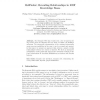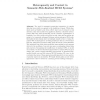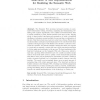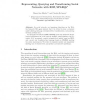SAMT
2009
Springer
14 years 6 months ago
2009
Springer
Abstract. The Semantic Web has recently seen a rise of large knowledge bases (such as DBpedia) that are freely accessible via SPARQL endpoints. The structured representation of the...
RULEML
2009
Springer
14 years 6 months ago
2009
Springer
Rule bases are increasingly being used as repositories of knowledge content on the Semantic Web. As the size and complexity of these rule bases s, developers and end users need met...
RR
2009
Springer
14 years 6 months ago
2009
Springer
Abstract. The Semantic Web is commonly perceived as a web of partially interlinked machine readable data. This data is inherently distributed and resembles the structure of the web...
OTM
2009
Springer
14 years 6 months ago
2009
Springer
The need for semantics preserving integration of complex data has been widely recognized in the healthcare domain. While standards such as Health Level Seven (HL7) have been develo...
ICCCI
2009
Springer
14 years 6 months ago
2009
Springer
Abstract. The Semantic Web promises increased precision in automated information sorting, searching, organizing and summarizing. Realizing this requires significantly more reliabl...
ESWS
2009
Springer
14 years 6 months ago
2009
Springer
Vocabularies are the building blocks of the Semantic Web providing shared terminological resources for content indexing, information retrieval, data exchange, and content integrati...
ESWS
2009
Springer
14 years 6 months ago
2009
Springer
As social networks are becoming ubiquitous on the Web, the Semantic Web goals indicate that it is critical to have a standard model allowing exchange, interoperability, transformat...
ESWS
2009
Springer
14 years 6 months ago
2009
Springer
The Semantic Web community has expressed its interest on how the Semantic Web technology can be applied more efficiently in a manner that supports real world applications. Addition...
ESWS
2009
Springer
14 years 6 months ago
2009
Springer
With the increasing storage capacity of personal computing devices, the problems of information overload and information fragmentation become apparent on users’ desktops. For the...
ESWS
2009
Springer
14 years 6 months ago
2009
Springer
Abstract. Semantic Web technologies such as RDF are usually incorporated in the infrastructure of desktop and web applications and can currently not be entirely deployed on mobile ...




